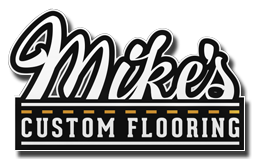Water and wood is the perfect recipe for problems. Wood, when exposed to water, can suffer from expanding or contracting which in turn can cause warping, bowing and crowning. Wood can even develop mold and decay if exposed to water overly long. Water damage can occur from a flood or even improper cleaning from over saturated mopping. When water damage occurs, it is important to repair the wood flooring correctly. Mike’s Custom Flooring will share how to detect water damage and what your can do to repair your floor.
How to Detect Water Damage in Your House
Water damages wood over time. Even if you believe you cleaned up the floor after a flood or spill, wood may continue to suffer. Other sources of water damages could be a leak from interior plumbing, or leaks in ceilings or walls. One of the early signs of water damage is when the planks begin to crown or cup. This creates high ridges between each plank. Wood expands when it absorbs water which crowds the wood. The edges of the board may even begin to buckle and turn upwards. Another common sign of water damage is when the wood begins to turn black. Wood will turn black from the combination of mold growth and prolonged exposure to water that is filled with minerals. Rust may occur around nails or staples, depending on the installation method.
How to Repair Water Damage on Hardwood Floors
Step 1. Your first step after detecting water damage is to locate the source of the flooding, leaking or water. If an unknown water source is present, locate it and repair or stop the source of the leak.
Step 2. If the water exposure or damage is regional, you will most likely need to replace those planks. At the source of the water damage, begin removing the damaged planks and keep removing the surrounding planks until the damaged planks are all gone. You may want to remove the one to two next to them even if they still look undamaged. Mold spreads quickly. To help prevent future mold exposure, it’s better to remove a few extra planks then replace the entire floor later.
Step 3. If any of the sub flooring is infected with water damage or mold, you may need to remove the sub flooring as well. Bleach the concrete foundation before relaying the new sub flooring. When reinstalling the new sub flooring, make sure to select the same size plywood. Next, reinstall the replacement wood planks.
Step 4. After the new planks have been reinstalled, strip the entire floor. Scrape away the loose flaky pieces of stain and sweep the floor clean. Next, sand the floor. This way the entire floor is smoothed. Re-stain and seal the floor to its original color. It’s important to refinish the entire floor to match the new planks with the old planks.
Hardwood Flooring Repair & More in Charles Town & Eastern Panhandle of Berkeley & Jefferson Counties in WV | Winchester & Frederick County | Round Hill & Loudoun County | Berryville & Clarke County | Herndon & Fairfax County VA
When water damage occurs to hardwood floors, it’s a lot of work to repair the damage. Depending on how badly the water damage was, the entire wood flooring may need to be replaced. The sub flooring may need to be removed and the foundation sterilized. If your wood floor has been affected with water, or water damage been discovered, contact Mike’s Custom Flooring. We provide water damage repairs along with many other services.





